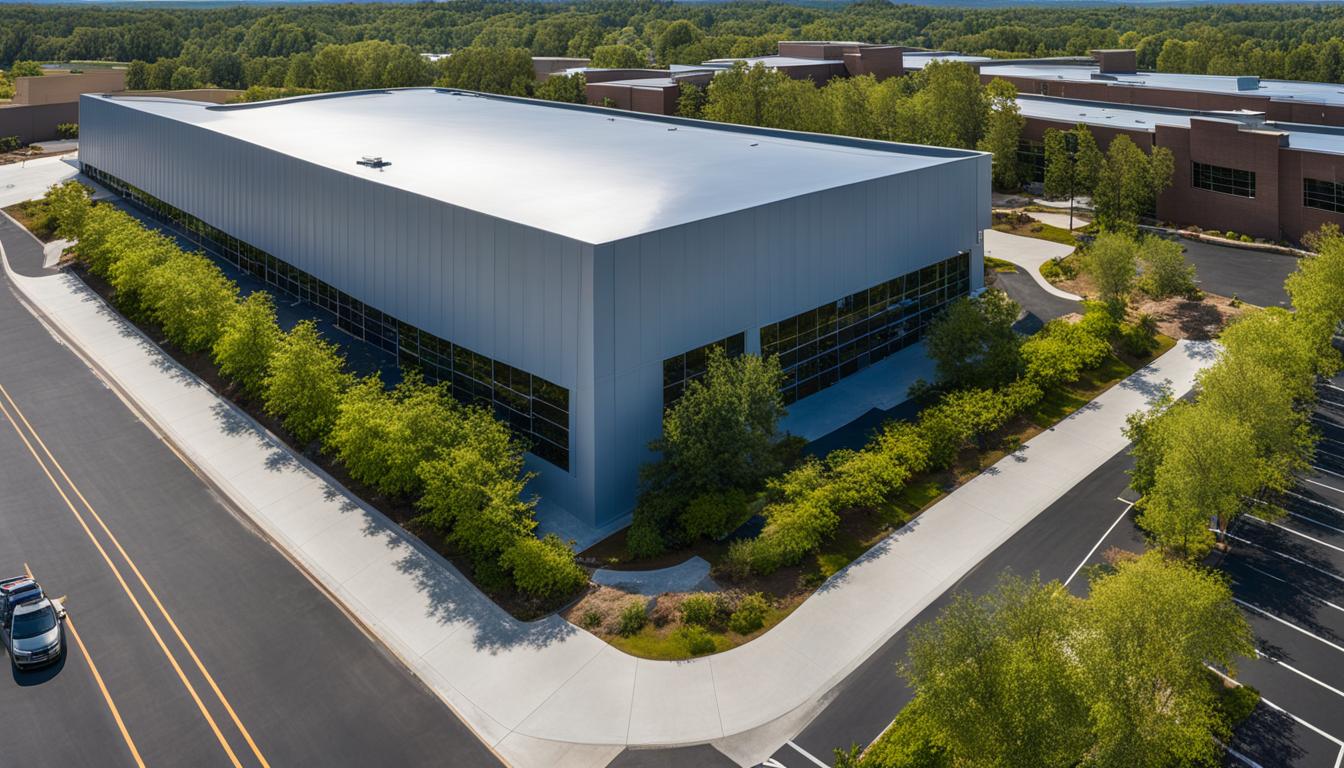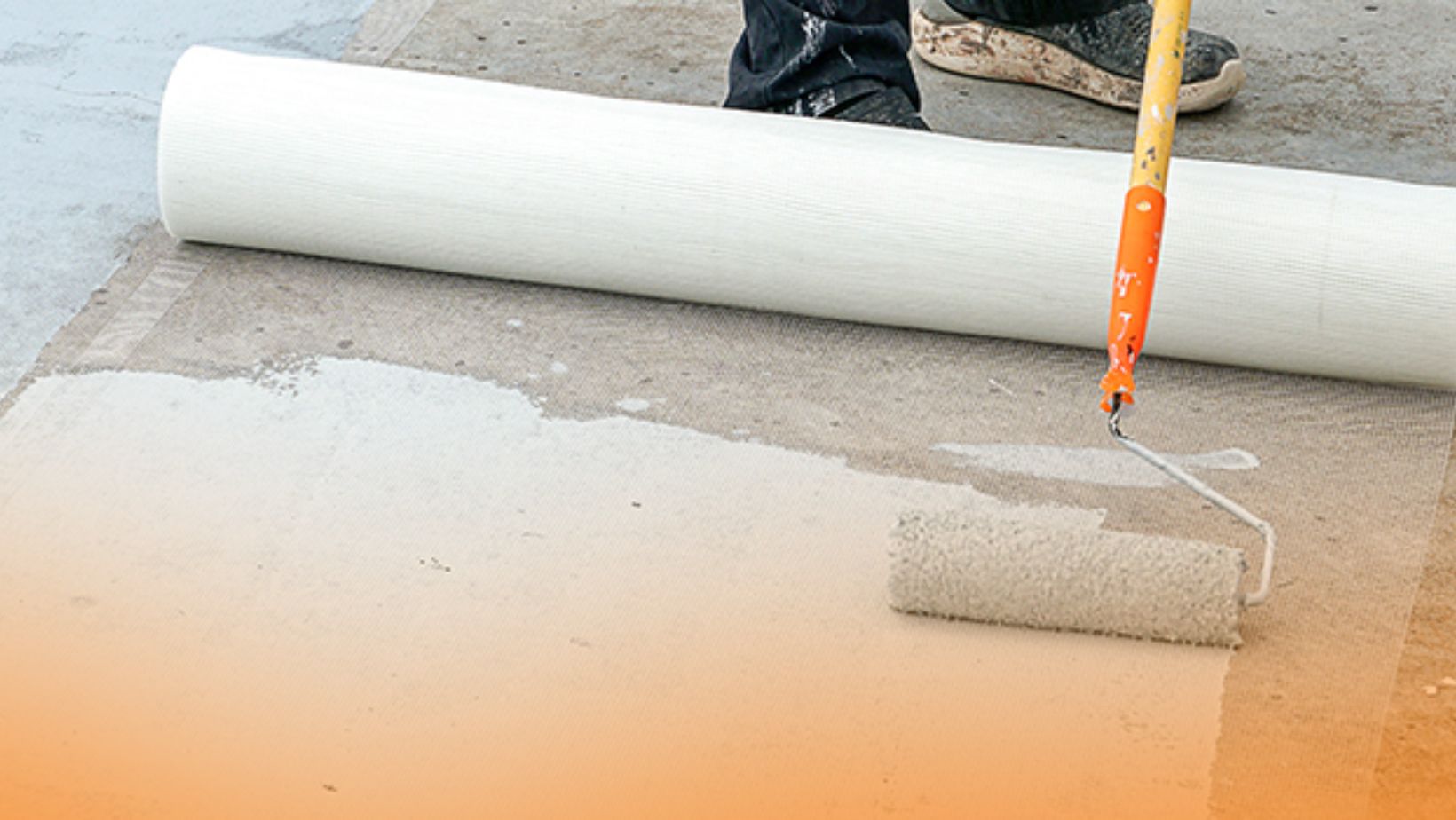Welcome to our ultimate guide on fluid applied roof membranes. If you’re in the market for roof coating systems or seeking liquid roofing solutions, you’ve come to the right place. In this comprehensive guide, we will explore everything you need to know about SmartSeal’s fluid applied roof membranes, from their benefits and applications to their sustainability and energy efficiency.
SmartSeal’s Fluid applied roof membranes are revolutionizing the commercial roofing industry. These seamless roofing systems provide a highly effective solution for waterproofing membranes, roof repair products, and sustainable roof membranes. With their elastomeric roof coatings and energy-efficient features, they are becoming increasingly popular among building owners and facility managers.
Key Takeaways:
-
- Fluid applied roof membranes are a durable and practical solution for commercial roofing
-
- They offer waterproofing capabilities and energy efficiency
-
- Seamless roofing systems reduce the risk of leaks and require minimal maintenance
-
- Elastomeric roof coatings provide flexibility and protection against extreme weather conditions
-
- SmartSeal’s Fluid applied roof membranes contribute to sustainable and environmentally friendly construction practices
Understanding Membrane Roofing
Membrane roofing is a specialized system designed specifically for flat roofs or roofs with low slopes. It provides a seamless and watertight seal, utilizing synthetic membranes that cover the entire roof area. These synthetic membranes, made from materials such as modified bitumen, EPDM, PVC, or TPO, offer exceptional adaptability, durability, and energy efficiency.
Unlike pitched roofs, which rely on slopes to shed water, membrane roofing ensures that water cannot pool or infiltrate the roof. The synthetic membranes create an impermeable barrier, protecting the structure from water damage and leaks. This makes membrane roofing an ideal solution for buildings with flat or low-slope roofs, providing reliable and long-lasting waterproofing.
Membrane roofing offers adaptability to various roof shapes and sizes, making it suitable for a wide range of commercial and residential applications. Its durability and strength allow it to withstand extreme weather conditions, UV radiation, and temperature fluctuations over time. Additionally, membrane roofing is highly energy efficient, as it can reflect sunlight and reduce heat absorption, resulting in lower cooling costs for the building.
| Advantages of Membrane Roofing |
|---|
| Watertight seal |
| Adaptability to various roof shapes |
| Durability and strength |
| Energy efficiency |
Brief History and Evolution
Membrane roofing has a rich history rooted in the need for innovative solutions for flat roofs. Traditional roofing materials like asphalt shingles were not suitable for flat or low-slope roofs, as they allowed water to pool and infiltrate, leading to leaks and damage. To overcome these challenges, synthetic materials came into play. In the mid-20th century, synthetic membranes such as EPDM (ethylene propylene diene monomer), PVC (polyvinyl chloride), and TPO (thermoplastic olefin) paved the way for a new era of roofing systems.
EPDM, PVC, and TPO offered a range of benefits that traditional roofing materials couldn’t match. These synthetic materials were highly durable, providing long-lasting protection against weathering and environmental stressors. They were also flexible and adaptable, capable of accommodating building movements and temperature fluctuations without compromising their integrity.
One of the significant advantages of membrane roofing is its sustainability. The development of synthetic materials reduced the reliance on non-renewable resources typically used in traditional roofing systems. EPDM, PVC, and TPO are recyclable and contribute to the overall environmental friendliness of membrane roofing.
Over time, membrane roofing systems have continued to evolve to meet the demands of the modern construction industry. Advanced technologies have been incorporated, making these systems more resistant to UV rays, enhancing their energy efficiency, and increasing their overall lifespan. Today, membrane roofing is a reliable and preferred choice for commercial buildings, providing a sustainable solution for flat roofs and low-slope roofs.
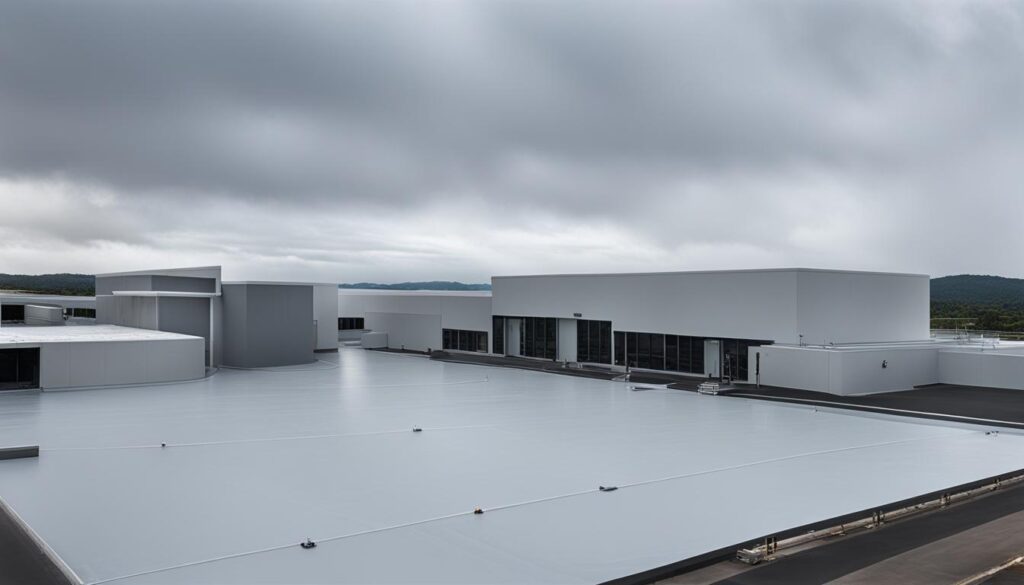
The Different Types of Membrane Roofing
When it comes to membrane roofing, there is a variety of options available to suit different needs and preferences. Let’s take a closer look at some of the popular types:
1. EPDM Roofing
EPDM roofing, also known as Ethylene Propylene Diene Monomer roofing, is a synthetic rubber membrane that offers exceptional durability and resistance to weathering. It can withstand extreme temperatures, UV rays, and harsh environmental conditions, making it a reliable choice for long-lasting protection.
2. TPO Roofing
TPO roofing, or Thermoplastic Olefin roofing, is a thermoplastic membrane that combines the advantages of rubber and plastic. It offers energy efficiency by reflecting heat, helping reduce cooling costs. TPO roofing is also lightweight and easy to install, making it a preferred choice for many.
3. PVC Roofing
PVC roofing, or Polyvinyl Chloride roofing, is another thermoplastic option that provides excellent resistance to chemicals, fire, and high temperatures. It offers exceptional durability and longevity, making it suitable for both residential and commercial applications.
4. Modified Bitumen Roofing
Modified bitumen roofing combines the reliability of traditional built-up roofing with modern technology. It consists of reinforced asphalt sheets that are modified with polymers for improved performance and flexibility. Modified bitumen roofing is known for its strength and resistance to extreme weather conditions.
5. Liquid-Applied Membranes
Liquid-applied membranes are a versatile choice for roof waterproofing and sealing. These membranes are applied in liquid form and then cure to form a seamless, monolithic surface. They provide excellent flexibility, protection against water infiltration, and are easy to maintain.
6. Green Roofing Systems
Green roofing systems, also known as vegetative or eco-roofs, offer an environmentally friendly and aesthetically pleasing solution. They consist of a waterproof membrane, layers of soil, and vegetation to create a living roof. Green roofing systems provide numerous benefits, including improved air quality, reduced energy consumption, and enhanced biodiversity.
Each type of membrane roofing has its unique advantages, so it’s important to consider factors such as climate, budget, and building requirements when choosing the most suitable option for your project.
Comparing Membrane Roofing with Traditional Materials
When it comes to roofing materials, there are various options available in the market. Traditional roofing materials like asphalt shingles, metal roofing, and tile roofing have been widely used for pitched or sloped roofs. However, when it comes to flat or low-slope roofs, membrane roofing emerges as a superior choice.
Membrane roofing provides a seamless and impermeable barrier that traditional materials cannot match. Unlike asphalt shingles, metal roofing, and tile roofing, which may have seams or overlaps, membrane roofing covers the entire roof area with synthetic membranes, creating a watertight seal.
Energy efficiency is a growing concern in today’s construction industry, and membrane roofing meets this demand effectively. Many membrane materials are designed with energy-saving properties, reflecting sunlight and reducing heat absorption. As a result, buildings with membrane roofing can enjoy lower energy costs and a more comfortable interior environment.
Maintenance is often a crucial factor when considering roofing materials. While traditional materials may require regular inspections, repairs, and replacements, membrane roofing is relatively easy to maintain. It offers a seamless surface that minimizes the risk of leaks and simplifies the maintenance process.
Overall, membrane roofing stands out as a modern and practical choice for flat or low-slope roofs.
Comparing Membrane Roofing with Traditional Materials
| Criteria | Membrane Roofing | Traditional Materials |
|---|---|---|
| Durability | High resistance to tearing, punctures, and weathering | Prone to deterioration over time |
| Flexibility | Can adapt to building movement and temperature fluctuations | Rigid structure, susceptible to cracking or damage |
| Energy Efficiency | Designed with energy-saving properties, reflecting sunlight and reducing heat absorption | Varies depending on material and color |
| Maintenance | Relatively easy to maintain with a seamless surface | May require regular inspections, repairs, and replacements |
Advantages Over Other Roofing Materials
When it comes to roofing materials, membrane roofing systems offer several advantages over traditional options. These modern systems are specifically designed to provide superior durability, flexibility, energy efficiency, waterproofing, and ease of maintenance.
Energy efficiency is also a significant advantage of membrane roofing systems. Many membrane materials have reflective properties that help to reduce heat absorption and minimize cooling costs during warm weather. This not only contributes to energy savings but also enhances the overall comfort of the building.
Overall, membrane roofing systems provide a durable, flexible, energy-efficient, waterproof, and easy-to-maintain solution for commercial buildings. Whether it’s a flat roof or a low-slope roof, membrane roofing is a reliable choice that offers a range of benefits for property owners.
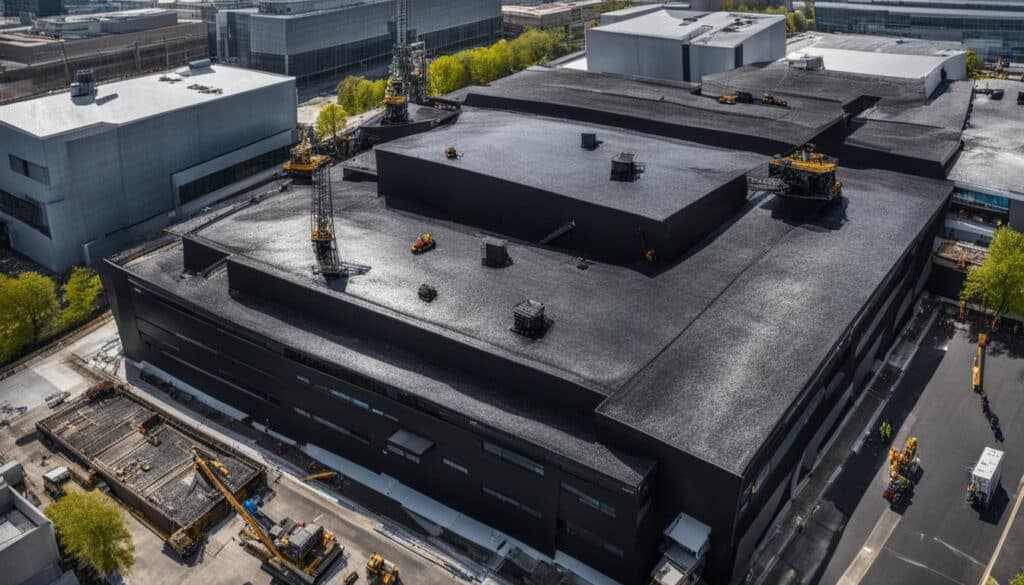
When to Choose Membrane Roofing
Membrane roofing is an ideal choice for various applications, including:
-
- Flat roofs and low-slope roofs: Membrane roofing systems are specifically designed to provide effective waterproofing on flat or low-slope roofs, preventing water pooling and potential leaks.
-
- Climate-exposed areas: Membrane roofing excels in weather-resistant properties, making it a suitable option for areas with harsh climates or high precipitation levels.
-
- Energy-efficient buildings: Membrane roofing materials often incorporate reflective properties, reducing heat absorption and cooling requirements, enhancing energy efficiency for the overall building system.
-
- Commercial buildings with larger roofs: Membrane roofing is a popular choice for commercial applications with extensive roof areas, providing seamless protection and longevity with lower maintenance needs.
By choosing membrane roofing, you ensure superior waterproofing capabilities and a cost-effective, long-term solution that meets the specific requirements of your building.
Introduction to Fluid-Applied Roof Coatings
Fluid-applied roof coatings offer an innovative solution for both new and existing roofing systems. These coatings can be applied directly to a new roof or as a re-roofing system over an existing deck, offering versatility and functionality. By applying fluid-applied roof coatings, you can extend the life of your existing roof while also enjoying energy-saving benefits.
One of the key advantages of fluid-applied roof coatings is their ability to create a reflective roof surface. This reflective property helps to reduce heat absorption, leading to lower energy costs and increased energy efficiency. By reflecting sunlight and heat, these coatings can minimize the strain on your building’s cooling systems and contribute to a more comfortable indoor environment.
Fluid-applied roof coatings create a seamless, monolithic surface that adheres fully to your existing roofing system. This seamless barrier provides optimal waterproofing and protection against leaks. It also eliminates the need for multiple seams and joints that can be prone to failure and water infiltration. With fluid-applied roof coatings, you can have peace of mind knowing that your roof is protected from the elements.
Furthermore, fluid-applied roof coatings are lightweight and easy to maintain. They are designed to withstand the elements and require minimal upkeep, saving you time and money on roof maintenance. With proper care and regular inspections, these coatings can maintain their effectiveness for years to come.
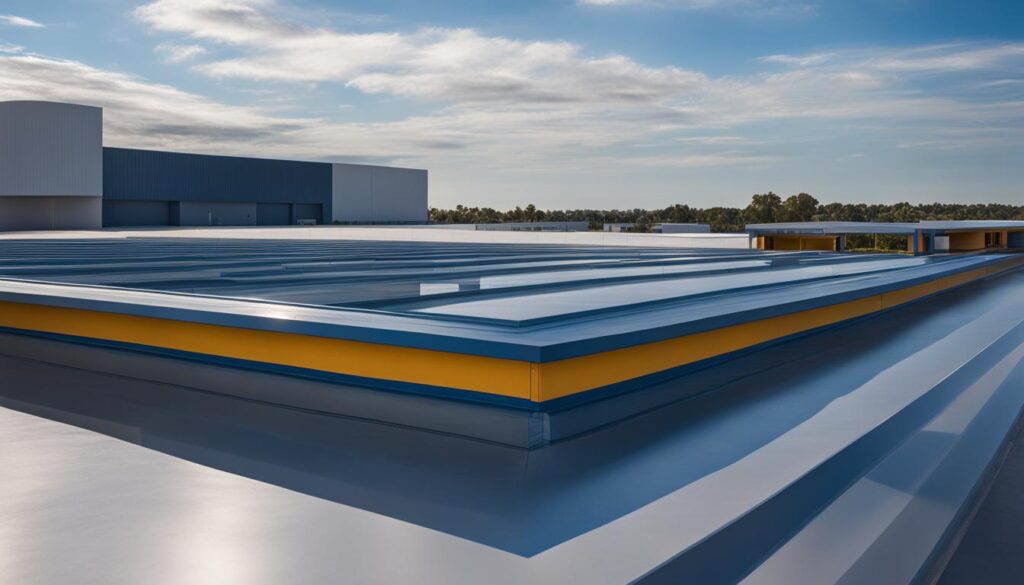
Fluid-applied roof coatings create a reflective roof surface to reduce energy costs.
Benefits of Fluid-Applied Roof Coatings
When it comes to roof maintenance, fluid-applied roof coatings offer a myriad of advantages. These coatings prove to be a valuable investment, extending the life of existing roofs and significantly reducing the need for costly roof tear-offs. In addition, they contribute to sustainability efforts by minimizing waste and providing energy savings through their reflective properties.
One of the key benefits of fluid-applied roof coatings is their ability to extend the life of existing roofs. These coatings act as a protective barrier, shielding the roof from damage caused by UV radiation, inclement weather, and natural wear and tear. By preventing leaks and reducing moisture infiltration, fluid-applied coatings help to preserve the structural integrity of the roof, ultimately increasing its lifespan.
By minimizing the need for roof tear-offs, fluid-applied roof coatings also contribute to waste reduction. Traditional roof replacement methods often involve removing the existing roof materials, leading to significant amounts of waste and debris. However, with fluid-applied coatings, the existing roof can be rejuvenated and reinforced, eliminating the need for unnecessary waste disposal.
Furthermore, fluid-applied roof coatings play a crucial role in energy savings. These coatings are designed to reflect sunlight and heat, reducing the amount of energy required to cool the building. By maintaining a cooler roof surface, fluid-applied coatings lower the demand for air conditioning, resulting in reduced energy consumption and lower utility bills.
Overall, fluid-applied roof coatings offer a range of benefits that make them an attractive choice for roof maintenance and sustainability. By extending the life of existing roofs, reducing waste, and providing energy savings, these coatings offer a cost-effective and environmentally conscious solution for commercial and residential roofing projects.
Surface Preparation for Successful Application
When it comes to applying fluid-applied coatings, surface preparation is crucial for ensuring a successful outcome. Proper preparation of the existing roof surface is essential to create a strong and durable bond between the coating and the substrate. Here are some key steps to follow:
Clean, Dry, and Secure
Before applying the fluid-applied coating, make sure that the roof surface is clean, dry, and free from any contaminants. This includes removing dirt, debris, oils, and loose materials. Thoroughly clean the surface using industry-approved cleaning agents and tools to ensure optimal adhesion.
Repair Damages and Deficiencies
Inspect the roof surface for any damages or deficiencies and address them before applying the coating. Repair any cracks, holes, or damaged areas to provide a smooth and even surface. This step is crucial to prevent water infiltration and ensure the long-term performance of the coating.
Identify Hidden Problems
Infra-red roof scans or core cuts can be invaluable in identifying hidden problems beneath the surface. These diagnostic techniques allow for the detection of moisture, insulation deficiencies, and other issues that may affect the coating’s performance. By identifying and addressing these problems early on, you can avoid potential complications in the future.
Enhance Adhesion with Priming
Depending on the specific conditions and the type of coating being applied, priming may be necessary to enhance adhesion. Primers create a bonding layer between the roof surface and the fluid-applied coating, ensuring a strong and durable bond. Follow manufacturer guidelines to select and apply the appropriate primer for your project.
Detailing Penetrations and Seams
To ensure a watertight seal, it’s important to pay attention to detailing penetrations and seams. Use self-adhered flashing tapes to reinforce these areas and provide added protection against water intrusion. Proper detailing is crucial for maintaining the integrity of the roof system and preventing costly leaks.
By following these surface preparation guidelines, you can optimize the performance and longevity of fluid-applied coatings. Taking the time to prepare the roof surface properly will contribute to a successful application and provide effective protection for years to come.
Conclusion
Fluid-applied roof membranes have gained significant popularity in the commercial roofing industry as they offer a range of benefits. Their durability, energy efficiency, and cost-effectiveness make them an attractive choice for building owners and managers. Moreover, fluid-applied roof membranes provide sustainable solutions that align with the growing emphasis on environmentally friendly practices in construction.
By using fluid-applied roof membranes, businesses can extend the lifespan of their existing roofs and reduce the need for costly replacements. These membranes create a seamless and watertight barrier, eliminating the risk of leaks and water damage. Additionally, they contribute to energy savings by providing effective insulation, reducing the need for heating and cooling, and lowering energy costs over time.
The commercial roofing industry will continue to demand fluid-applied roof membranes due to ongoing advancements in technology and the availability of various liquid roofing products. As experts in the field, we understand the value these sustainable solutions bring. We prioritize the use of fluid-applied roof membranes to provide our clients with long-lasting, energy-efficient, and environmentally conscious roofing options.
FAQs
What is membrane roofing?
Membrane roofing is a specialized roofing system used for flat or low-slope roofs. It involves the use of synthetic membranes to create a seamless and waterproof barrier that protects against water pooling and infiltration.
How does membrane roofing differ from traditional roofing materials?
Membrane roofing is specifically designed for flat or low-slope roofs, while traditional materials like asphalt shingles, metal roofing, and tile roofing are primarily used for pitched roofs. Membrane roofing provides a seamless and impermeable barrier that traditional materials cannot match, along with advantages such as durability, flexibility, energy efficiency, and ease of maintenance.
What are the advantages of membrane roofing?
Membrane roofing systems offer several advantages, including resistance to tears, punctures, and weathering. They can accommodate building movement and temperature fluctuations better than rigid materials. Membrane roofing is also energy efficient, with many materials reflecting sunlight and heat. Additionally, it is easier to inspect, repair, and maintain compared to traditional roofing systems.
What types of membrane roofing are available?
There are several types of membrane roofing available, including EPDM roofing made from synthetic rubber for durability and weather resistance, TPO roofing for energy efficiency and ease of installation, PVC roofing for chemical and fire resistance, as well as modified bitumen roofing, liquid-applied membranes, and green roofing systems.
When should I choose membrane roofing?
Membrane roofing is an ideal choice for flat or low-slope roofs, climate-exposed areas, buildings that prioritize energy efficiency, and commercial buildings with larger roofs. It offers superior waterproofing capabilities and longevity, making it a cost-effective and long-term solution for many buildings.
What are fluid-applied roof coatings?
Fluid-applied roof coatings are versatile solutions that can be applied as a new roofing system or as a re-roofing system over an existing deck. They prolong the life of existing roofs, contribute to energy savings by creating a reflective roof surface, and provide a seamless, monolithic surface that is fully adhered, waterproof, lightweight, and easy to maintain.
What are the benefits of fluid-applied roof coatings?
Fluid-applied roof coatings offer several benefits, including extending the life of existing roofs, reducing the need for roof tear-offs, contributing to sustainability by reducing waste, and providing energy-saving reflective properties. These coatings are lightweight, self-flashing, and can be reapplied every 5 to 15 years with proper maintenance.
What is the surface preparation required for successful application of fluid-applied coatings?
Surface preparation is crucial for the successful application of fluid-applied coatings. The existing roof surface must be clean, dry, and secure, with repairs made to any damages or deficiencies. Infra-red roof scans or core cuts can help identify hidden problems. Priming may be necessary to enhance adhesion, and self-adhered flashing tapes can be used for detailing penetrations and seams.
Why are fluid-applied roof membranes popular in the commercial roofing industry?
Fluid-applied roof membranes have become popular due to their durability, energy efficiency, and cost-effectiveness. They provide sustainable solutions that extend the life of existing roofs and contribute to energy savings. With continued advancements in technology and the availability of various liquid roofing products, fluid-applied roof membranes will continue to be in high demand.
Source Links

